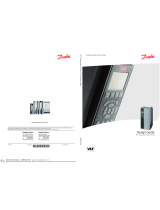
FC 300 Design Guide
" Acoustic Noise ....................................................................................... 64
" Peak Voltage on Motor ............................................................................ 64
" Derating for Ambient Temperature - data valid for ≤ 7.5 kW ........................ 65
" Derating for Low Air Pressure .................................................................. 65
" Derating for Running at Low Speed .......................................................... 65
" Derating for Installing Long Motor Cables or C ables with Large r Cross-Section 66
" Temperature-Dependent Switch Frequency ................................................ 66
" Mechanical Dimension ............................................................................ 67
" Options and Accessories ......................................................................... 68
" Mounting of Option Modules in Slot B ........................................................ 68
" General Purpose Input Output Module MCB 101 ......................................... 68
" Encoder Option MCB 102 ........................................................................ 70
" Resolver Option MCB 103 ........................................................................ 72
" Relay Option MCB 105 ............................................................................ 74
" 24 V Back-Up Option MCB 107 (Option D) ................................................. 77
" Brake Resistors ..................................................................................... 78
" Remote mounting Kit for LCP ................................................................... 78
" IP 21/IP 4X/ TYPE 1 Enclosure Kit ............................................................ 78
" IP 21/Type 1 Enclosure Kit ...................................................................... 78
" LC Filters .............................................................................................. 79
! How to Order .................................................................................... 81
" Drive Configurator ................................................................................. 81
" Ordering Form Type Code ........................................................................ 81
" Ordering Numbers ................................................................................. 83
! How to Install .................................................................................. 89
" Mechanical Installation ........................................................................... 89
" Accessory Bag ≤ 7.5 kW ......................................................................... 89
" Safety Requirements of Mechanical Installation .......................................... 91
" Field Mounting ....................................................................................... 91
" Electrical Installation .............................................................................. 92
" Removal of Knockouts for Extra Cables ..................................................... 92
" Connection to Mains and Earthing ............................................................ 92
" Motor Connection ................................................................................... 94
" Motor Cables ......................................................................................... 96
" Electrical Installation of Motor Cables ........................................................ 96
" Fuses ................................................................................................... 97
" Access to Control Terminals ..................................................................... 99
" Control Terminals (FC 301) ...................................................................... 99
" Electrical Installation, Control Terminals ................................................... 100
" Basic Wiring Example ............................................................................ 100
" Electrical Installation, Control Cables ....................................................... 101
" Switches S201, S202, and S801 ............................................................. 102
" Final Set-Up and Test ............................................................................ 103
" Safe Stop Installation (FC 302 only) ........................................................ 105
" Safe Stop Commissioning Test ................................................................ 106
" Additional Connections .......................................................................... 107
" Load Sharing ........................................................................................ 107
" Installation of Loadsharing ..................................................................... 107
" Brake Connection Option ....................................................................... 107
" Relay Connection .................................................................................. 108
" Relay Output ........................................................................................ 109
" Parallel Connection of Motors .................................................................. 109
2
MG.33.B6.02 - VLT is a registered Danfoss trademark





















